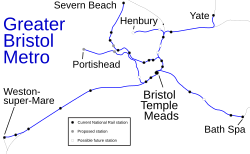
Bristol Temple Meads is the oldest and largest railway station in Bristol, England. It is located 118 miles 31 chains away from London Paddington. It is an important transport hub for public transport in the city; there are bus services to many parts of the city and surrounding districts, with a ferry to the city centre. Bristol's other major station, Bristol Parkway, is a more recent station on the northern outskirts of the conurbation.
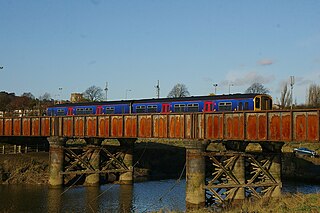
The Severn Beach line is a local railway line in Bristol and Gloucestershire, England, which runs from Bristol Temple Meads to Severn Beach, and used to extend to Pilning. The first sections of the line were opened in 1863 as part of the Bristol Port Railway and Pier; the section through Bristol was opened in 1875 as the Clifton Extension Railway.

Clifton Down railway station is on the Severn Beach line and serves the district of Clifton in Bristol, England. It is 3.9 miles (6.3 km) from Bristol Temple Meads. Its three letter station code is CFN. The station has two platforms, each serving trains in one direction only. As of 2015 it is managed by Great Western Railway, which is the third franchise to be responsible for the station since privatisation in 1997. They provide all train services at the station, mainly a train every 30 minutes in each direction.

The Portishead Railway is a branch line railway running from Portishead in North Somerset to the main line immediately west of Bristol, England. It was constructed by the Bristol & Portishead Pier and Railway Company, but it was always operated by its main line neighbour, and was more usually thought of as the Portishead branch or the Portishead railway.
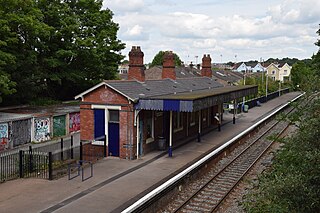
Redland railway station is on the Severn Beach Line and serves the districts of Cotham and Redland in Bristol, England. It is 3.3 miles (5.3 km) from Bristol Temple Meads. Its three letter station code is RDA. As of 2015 it is managed by Great Western Railway, which is the third franchise to be responsible for the station since privatisation in 1997. They provide all train services at the station, mainly a train every 30 minutes in each direction.
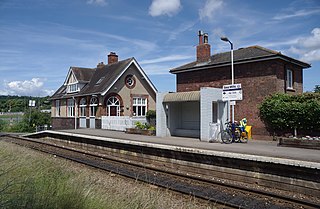
Sea Mills railway station is on the Severn Beach Line and serves the district of Sea Mills and nearby Westbury on Trym in Bristol, England. It is 6 miles (9.7 km) from Bristol Temple Meads, situated at the confluence of the River Avon and River Trym and near the A4 Bristol Portway. Its three letter station code is SML. The station has a single platform which serves trains in both directions. As of 2015 it is managed by Great Western Railway, which is the third franchise to be responsible for the station since privatisation in 1997. They provide all train services at the station, mainly a train every 30 minutes in each direction.
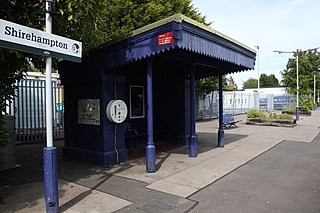
Shirehampton railway station is on the Severn Beach Line and serves the district of Shirehampton in Bristol, England. It is 7.6 miles (12.2 km) from Bristol Temple Meads. Its three letter station code is SHH. The station has a single platform which serves trains in both directions. As of 2015 it is managed by Great Western Railway, which is the third franchise to be responsible for the station since privatisation in 1997. They provide all train services at the station, mainly a train every 30 minutes in each direction.
Bristol is a city in south west England, near the Bristol Channel coast, approximately 106 miles (170 km) west of London. Several factors have influenced the development of its transport network. It is a major centre of employment, retail, culture and higher education, has many historic areas, and has a history of maritime industry. The city has a population of 450,000, with a metropolitan area of 650,000, and lies at the centre of the former County of Avon, which includes many dormitory towns, and has a population of one million.
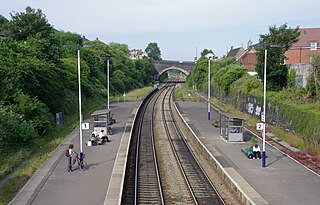
Parson Street railway station serves the western end of Bedminster in Bristol, England. It also serves other surrounding suburbs including Bishopsworth, Ashton Vale and Ashton Gate, along with Bristol City FC. It is 2 miles (3.2 km) from Bristol Temple Meads, and 120 miles (193 km) from London Paddington. Its three letter station code is PSN. It was opened in 1927 by the Great Western Railway, and was rebuilt in 1933. The station, which has two through-lines and two platforms, plus one freight line for traffic on the Portishead Branch Line, has minimal facilities. As of 2020, it is managed by Great Western Railway, which is the sixth company to be responsible for the station, and the third franchise since privatisation in 1997. They provide all train services at the station, mainly an hourly service between Bristol Parkway and Weston-super-Mare.
The majority of public transport users in the Bristol Urban Area are transported by bus, although rail has experienced growth and does play an important part, particularly in peak hours. There were plans for a light rail system, however this has now been dropped although it remains in the long-term local transport plan.
Chittening Platform railway station was a station on the former Great Western Railway between Filton and Avonmouth.
Rail services in the West of England refer to passenger rail journeys made in the Bristol commuter area. 17 million passenger rail journeys were made in 2019-20 within the Gloucestershire, Wiltshire and Bristol/Bath region.

Ashton Gate railway station was a railway station serving the Ashton Gate area of Bristol, England, which included Ashton Gate football ground, the home ground of Bristol City F.C. It was located on the Portishead Railway.

Clifton Bridge railway station is a former railway station in the Bower Ashton district of Bristol, England, near the River Avon. It was opened in 1867 by the Bristol and Portishead Pier and Railway Company as a single platform stop 3.4 miles (5.5 km) along the line from Bristol to Portishead. It was later taken over by the Great Western Railway and had a second platform added.

Pill railway station was a railway station on the Portishead Branch Line, 7.8 miles (12.6 km) west of Bristol Temple Meads, serving the village of Pill in North Somerset, England. The station was opened by the Bristol and Portishead Pier and Railway Company on 18 April 1867. It had two platforms, on either side of a passing loop, with a goods yard and signal box later additions. Services increased until the 1930s, at which point a half-hourly service operated. However the Portishead Branch was recommended for closure by the Beeching report, and the station was closed on 7 September 1964, although the line saw freight traffic until 1981. Regular freight trains through the station began to run again in 2002 when Royal Portbury Dock was connected to the rail network.
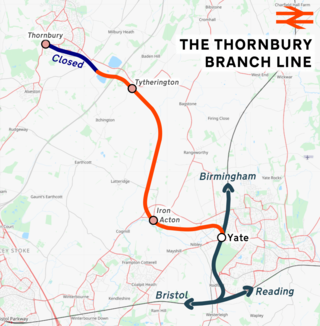
The Thornbury branch line is a railway line from Yate to Thornbury in the West of England. From 1963 until mid 2013, it remained as a freight route, serving the quarry at Tytherington. It was designated 'Out of Use (temporary)' by Network Rail from 2013 until 2017, when it reopened to serve Tytherington quarry again. The 7.5-mile (12 km) branch of the Midland Railway line between Bristol and Gloucester opened on 2 September 1872, and started at Yate and finished at Thornbury, with stops at Iron Acton and Tytherington.
Bristol Rail Campaign is a Bristol-based campaign group, calling for better rail transport in the Bristol area.

Henbury railway station served the Bristol suburb of Henbury, England, from 1910 to 1965. The station was situated on the Henbury Loop Line of the Great Western Railway and was opened on 9 May 1910 for passenger services. Under the Beeching cuts, it was closed to passengers on 23 November 1964, with goods services ceasing on 5 July 1965. There is a proposal to reopen the station as part of the Greater Bristol Metro scheme.

Hallen Halt railway station was a railway station in Hallen, Gloucestershire, England, on the Henbury Loop Line. The station is closed, and the line is closed to passengers.
Charlton Halt railway station was a railway station which served the village of Charlton, west of Filton in South Gloucestershire, England, on the Avonmouth and Filton Railway, now known as the Henbury Loop Line. The station was open only between May 1910 and March 1915, when the line was closed to passengers. The line was reopened to passengers from 1922 to 1964, but the station was not reopened.
